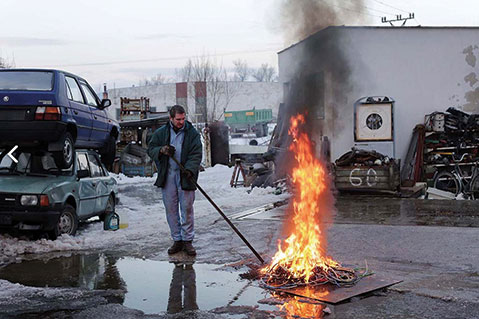‘Koza’
Director Ivan Ostrochovský

Languidly paced, texturally gritty, and groundbreaking in production style, this feature film portrays a poor Romany boxer, a former Olympiad from Slovakia who must endure a series of last fights to get enough money to convince his girlfriend not to abort their coming child. The actor is actually a pro boxer, some of the scenes are actual matches, and this film punches you square in the gut, repeatedly.
U.S. PREMIERE
Why did you decide to portray this story?
For its clear message and dramatic potential.
Did Koza truly fight as part of his role?
Half of the scenes in the film are staged, half of them are real. The last match we see Peter “Koza” Balaz boxing is, for example, one of the real ones. I was waiting for it for almost a year and only when we finished it did I know I could proceed with the editing. We didn’t want to make the environment of the boxing matches attractive by dynamic editing or with camera movement. The environment, which the main characters is set in, is far from attractive, to be honest.
Tell me more about why you hired him as an actor.
Peter is not a professional actor; he is a professional boxer. I chose him because he had the greatest charisma of the other possibilities at that moment – both actors and non-professional actors. When you are a filmmaker from a small country, with a small budget, your possibilities of casting actors are also limited.
What were the advantages and disadvantages of using an amateur in this role?
One of the disadvantages would surely be less plasticity for the character, but on the other hand, it also brings more authenticity with it. You can’t write complicated dialogues for a non-professional actor and make the dialogues last for very long. It’s simply a much slower process with the non-professional actors and you move step by step.
But on the other hand, if your main character is an unemployed Romany guy, you got a lot of time for rehearsals. When you see a well-known professional actor box, you feel and know you’re watching a show, performance. Though of course, there’s a plenty of great films with professional actors in the role of a boxer. It’s just not what I wanted.
Do you have tips for filmmakers who want to tell evocative stories but don’t have a big budget?
In a way, you’ve answered your own question. If you don’t have a big budget, you need a strong story. The power of a good story can make up for, in some cases, the missing money. And apart from that, it motivates the author to work out problems. Sometimes, low budgets can even bring a sort of an “economy in expression” and effect the length of the film. Films nowadays often suffer by being half an hour longer than needed.
It’s however hard for me to give advice to small American independent productions, as their situation is much different to the one we have in Europe. Europe has a relatively good system of support of film production, so there’s a big chance you will be able to shoot a film, even if not in the greatest conditions. So if am I to advise anything to American independent filmmakers, it would be to cooperate with European productions in a greater extent — I do think it would be an interesting combination.
What do you hope will happen with this film and what is your next project?
Since Koza premiered at the Berlinale in February 2015, it went through a pretty excited and busy festival life. We took part at approximately 50 festivals worldwide: Toronto, Mar del Plata, Karlovy Vary, Shanghai, Thessaloniki, Warsaw, and received over 20 awards.
My new project is called The Disciple and follows the collaboration of some of the Catholic priests with the secret police during the Communist regime in Czechoslovakia. The story is set in the 1980s and tells the story of a protest hunger strike of some of the students of the Catholic seminary.



